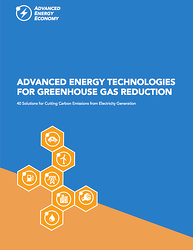 In the first blog post in this series, we talked about how EPA’s forthcoming rule on greenhouse gas emissions (GHGs) from existing power plants – known as 111(d) for the section of the Clean Air Act under which the rules are being developed – presents a unique opportunity to modernize the power grid for the 21st Century. We made the argument that we could create a high-performing grid that was efficient, clean, and affordable, and that advanced energy technologies could help make the use of both energy and capital more efficient. In this post, we look at some other important aspects of a high-performing grid, namely reliability, resiliency, and restoration – the “3Rs” of an electric power system we can count on. As with efficiency in energy and capital, we can achieve improved reliability, resiliency, and restoration by using many of the same technologies that can drive down GHG emissions.
In the first blog post in this series, we talked about how EPA’s forthcoming rule on greenhouse gas emissions (GHGs) from existing power plants – known as 111(d) for the section of the Clean Air Act under which the rules are being developed – presents a unique opportunity to modernize the power grid for the 21st Century. We made the argument that we could create a high-performing grid that was efficient, clean, and affordable, and that advanced energy technologies could help make the use of both energy and capital more efficient. In this post, we look at some other important aspects of a high-performing grid, namely reliability, resiliency, and restoration – the “3Rs” of an electric power system we can count on. As with efficiency in energy and capital, we can achieve improved reliability, resiliency, and restoration by using many of the same technologies that can drive down GHG emissions.
First let’s define the 3Rs. Reliability refers to the ability of the grid to consistently provide electricity to all customers in sufficient quantity and quality to meet demand. Resiliency is related to reliability, but refers to the ability of the grid to withstand abnormal events, such as extreme weather, unexpected generator outages, and even deliberate physical or cyber attack. In the event of outages, restoration needs to be achieved quickly; this includes the ability to locate and diagnose outages, and then to make repairs quickly.
Our aging grid is becoming more susceptible to outages – especially due to increased frequency of severe weather events – at the same time as we are becoming more dependent on electricity in a 21st Century digital economy. The U.S. Department of Energy identified 679 widespread power outages due to severe weather between 2003 and 2012 – at cost of $18 billion to $33 billion in inflation-adjusted annual losses. Eaton’s Blackout Tracker Annual Report for 2013 identified 3,236 power outages last year alone. This says nothing of the risks to life and property of such outages, especially extended outages.
“Our nation’s electric energy infrastructure is a patchwork system that has evolved over a long period of time, with equipment of widely differing ages and capacities,” says the American Society of Civil Engineers. “Nationally, 70% of transmission lines and power transformers are 25 years or older, while 60% of circuit breakers are more than 30 years old.” Clearly, if we want a grid that is high in the 3Rs, modernization is in order.
Advanced energy technologies make the grid more intelligent and flexible – two attributes that are necessary for the 3Rs. Energy storage and flexible generation using advanced gas turbines can help integrate rising levels of variable renewable generation; distribution automation and advanced metering infrastructure can give utilities greater visibility into and control over their distribution networks – allowing them to better respond to changing conditions, reroute power around faults, and more rapidly identify outages and restore power. Eventually, utilities and third parties are expected to be able to integrate distributed generation into grid planning and operations, turning them into valuable assets for the grid, not just their owners.
In the wake of Hurricane Sandy, customer-owned microgrids kept the lights on for days at university and hospital campuses and housing complexes. In the future, more microgrids, including utility-owned systems, could become an integral part of grid operations.
Empowering customers with energy use information will give them more service options and more control over energy use and costs, and also make their load more responsive. Demand response (DR) is already becoming an important tool for increasing grid reliability and avoiding the need for expensive investments to meet peak demand. During the January “polar vortex,” the Electric Reliability Council of Texas (ERCOT) reported that demand response programs provided 496 MW of capacity to the grid within 46 minutes of a demand response dispatch call – output equivalent to an average-sized coal-fired power plant. In the future, an intelligent grid with empowered customers could provide significantly more DR capacity, and thus make the grid more reliable and resilient.
The 3Rs provide more reasons for why the upcoming EPA rulemaking should be viewed as an opportunity to modernize our grid while also reducing greenhouse gas emissions from the electric power sector. Utilities are already feeling pressures from technology and market trends that have the potential to disrupt their current business model. Acting boldly today to create a modern electricity system, and a modern regulatory system to match it, can help manage this transition and pay huge dividends in the years to come.
This blog is the second in a three-part series. Read part 1 here and part 3 here.
